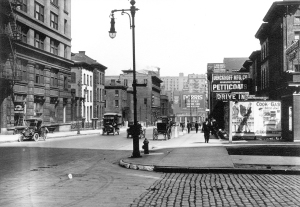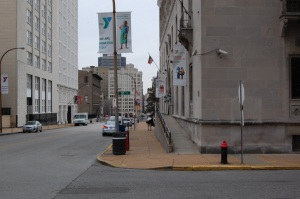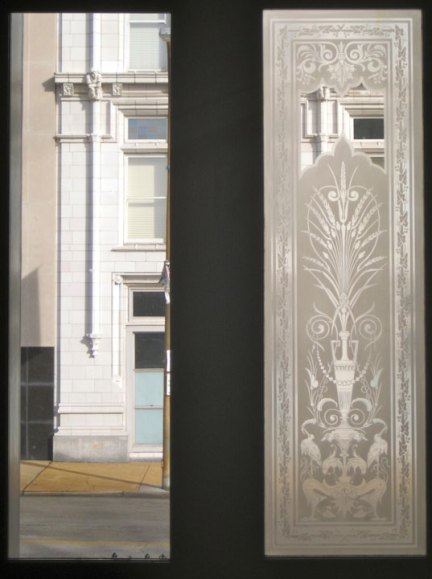“At Fourteenth Street begins one of the beauty spots of St. Louis, commonly known as Lucas Place. For full three blocks not a shanty rears its head. All the houses are large and handsome, and the shade trees the best the city can show. The street is paved with large blocks of limestone, and is, consequently, very clean. It is an intensely quiet spot, and if children live there they are kept within doors, and are never allowed to make mud pies in the gutter…”
St. Louis Post-Dispatch, 16 October 1880
For only 40 years Lucas Place was the showplace street for St. Louis’ rich and powerful. Populated by successful merchants, politicians, military officers and physicians, Lucas Place was surrounded by some of the city’s finest institutions, including Washington University, Mary Institute, the Saint Louis Art Museum, and the first public high school west of the Mississippi.
But today a visitor to downtown St. Louis would never know such a place existed. Even the name Lucas Place has disappeared. Today we call it Locust Street. It is truly a lost neighborhood that exists only in photos and newspaper stories. Campbell House is of course the exception to this statement. Beginning in 1851 it was at the heart of the neighborhood and today it is all that is left of Lucas Place.
For decades the Campbell House Museum has been collecting an archive of material about Lucas Place and now you have a chance to see the buildings and read the stories that made this street the heart of Gilded Age St. Louis in a new exhibit.
Lucas Place: The Lost Neighborhood of St. Louis’ Gilded Age opens with a reception this Friday, March 22 between 5:30 and 8 p.m. at Architecture St. Louis, the office of Landmarks Association, 911 Washington Avenue, Suite 170. Free and open to the public. The exhibit will be open through July and can be viewed 9 a.m. to 5 p.m., Monday through Friday.
There is also a coordinating series of lectures about Lost Neighborhoods in St. Louis which is listed below.
Landmarks Association and Campbell House Museum are sponsoring this program in partnership with the Missouri Humanities Council with support from the National Endowment for the Humanities.
Lecture Series: Lost Neighborhoods of St. Louis
Monday, April 1: Bob Moore, Chief Historian at the Jefferson National Expansion Memorial – Bob will discuss Colonial St. Louis and lead a digital tour of his 3D model of the town. 12:00–1:15. (Kranzberg Arts Center).
Thursday, April 4: Bob Moore – Bob will follow his discussion of Colonial St. Louis with an examination of Early American St. Louis. 12:00–1:15. (Kranzberg Arts Center).
Thursday, April 11: Ron “Johnny Rabbit” Elz — Gaslight Square. Ron will discuss the people, buildings, and venues that defined one of St. Louis’ greatest entertainment districts. (Gaslight Theater, 358 N. Boyle. Doors at 7:00, presentation 7:30–9:00). * This is an evening lecture.
Thursday, April 18: Dr. Huping Ling, Professor of History and founder of the Asian Studies Program at Truman State University – Professor Ling will discuss the 19th and 20th century Chinese enclave that once thrived in downtown St. Louis. 6:30–8:00. Kranzberg Arts Center. * This is an evening lecture.
Thursday, April 25: Michael Allen, architectural historian and director of the Preservation Research Office, — Michael will discuss the DeSoto-Carr Neighborhood and its successor, the Pruitt-Igoe Housing Complex. 12:00–1:15. (Kranzberg Arts Center).
Thursday, May 2: Andy Hahn, Director, Campbell House Museum, and historian Tom Gronski- Andy and Tom will discuss the buildings and residents of Lucas Place. 12:00–1:15. (Kranzberg Arts Center).
Thursday, May 9: Thomas Danisi, local historian and author of the critically acclaimed book Discovering Meriwether Lewis – Thomas will discuss his new research into early settlement of the St. Louis Common Fields. 12:00–1:15. (Kranzberg Arts Center).
The Kranzberg Arts Center is located at 501 N. Grand in Grand Center. Street parking or at the Scottish Rite Garage, 3634 Olive. Feel free to bring lunch to the daytime talks. Talks are free and open to the public.
For more information please call 314–421-0325.



















